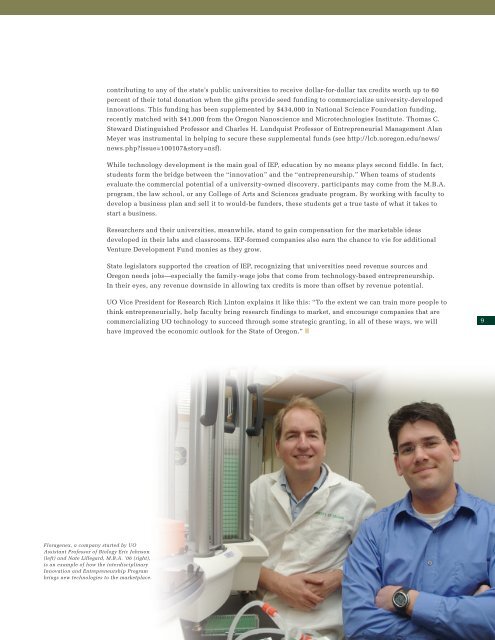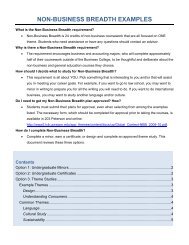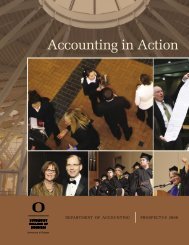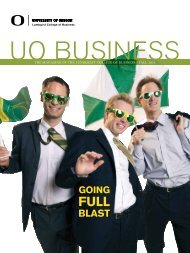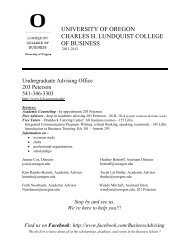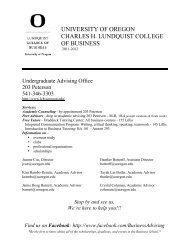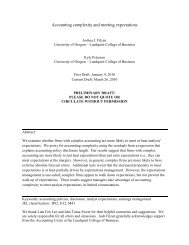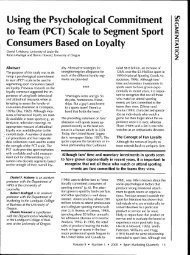The Business of Writing - Lundquist College of Business - University ...
The Business of Writing - Lundquist College of Business - University ...
The Business of Writing - Lundquist College of Business - University ...
- TAGS
- lundquist
- lcb.uoregon.edu
Create successful ePaper yourself
Turn your PDF publications into a flip-book with our unique Google optimized e-Paper software.
Floragenex, a company started by UO<br />
Assistant Pr<strong>of</strong>essor <strong>of</strong> Biology Eric Johnson<br />
(left) and Nate Lillegard, M.B.A. ’06 (right),<br />
is an example <strong>of</strong> how the interdisciplinary<br />
Innovation and Entrepreneurship Program<br />
brings new technologies to the marketplace.<br />
contributing to any <strong>of</strong> the state’s public universities to receive dollar-for-dollar tax credits worth up to 60<br />
percent <strong>of</strong> their total donation when the gifts provide seed funding to commercialize university-developed<br />
innovations. This funding has been supplemented by $434,000 in National Science Foundation funding,<br />
recently matched with $41,000 from the Oregon Nanoscience and Microtechnologies Institute. Thomas C.<br />
Steward Distinguished Pr<strong>of</strong>essor and Charles H. <strong>Lundquist</strong> Pr<strong>of</strong>essor <strong>of</strong> Entrepreneurial Management Alan<br />
Meyer was instrumental in helping to secure these supplemental funds (see http://lcb.uoregon.edu/news/<br />
news.php?issue=100107&story=nsf).<br />
While technology development is the main goal <strong>of</strong> IEP, education by no means plays second fiddle. In fact,<br />
students form the bridge between the “innovation” and the “entrepreneurship.” When teams <strong>of</strong> students<br />
evaluate the commercial potential <strong>of</strong> a university-owned discovery, participants may come from the M.B.A.<br />
program, the law school, or any <strong>College</strong> <strong>of</strong> Arts and Sciences graduate program. By working with faculty to<br />
develop a business plan and sell it to would-be funders, these students get a true taste <strong>of</strong> what it takes to<br />
start a business.<br />
Researchers and their universities, meanwhile, stand to gain compensation for the marketable ideas<br />
developed in their labs and classrooms. IEP-formed companies also earn the chance to vie for additional<br />
Venture Development Fund monies as they grow.<br />
State legislators supported the creation <strong>of</strong> IEP, recognizing that universities need revenue sources and<br />
Oregon needs jobs—especially the family-wage jobs that come from technology-based entrepreneurship.<br />
In their eyes, any revenue downside in allowing tax credits is more than <strong>of</strong>fset by revenue potential.<br />
UO Vice President for Research Rich Linton explains it like this: “To the extent we can train more people to<br />
think entrepreneurially, help faculty bring research findings to market, and encourage companies that are<br />
commercializing UO technology to succeed through some strategic granting, in all <strong>of</strong> these ways, we will<br />
have improved the economic outlook for the State <strong>of</strong> Oregon.”<br />
9


